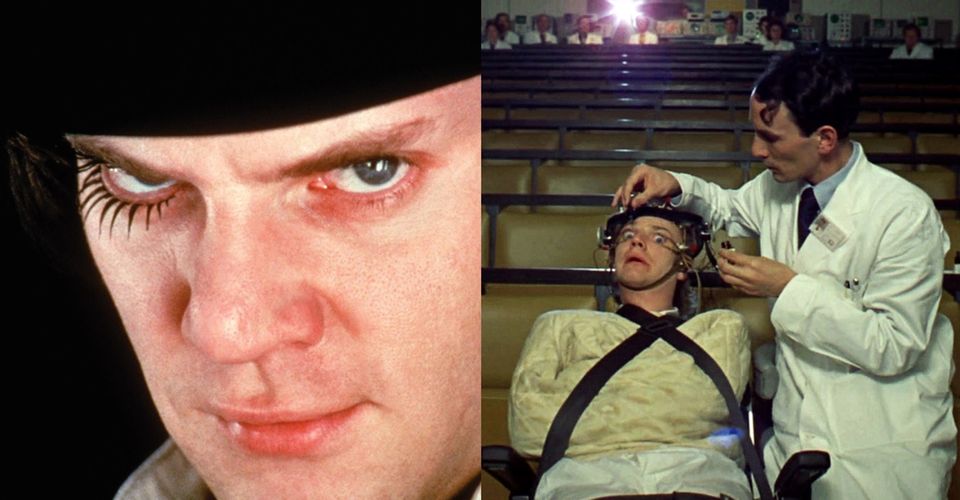A Clockwork Orange: 10 Things That Still Hold Up Today

Stanley Kubrick’s A Clockwork Orange is one of the most controversial movies ever made. It has some of the most disturbing violence ever put on film and its so-called protagonist goes on a sadistic crime spree in the opening scenes. On its initial release, the movie was given an X rating and was officially “condemned” by the National Catholic Office for Motion Pictures.
Although this movie is half a century old this year, it hasn’t lost any of its emotional impact or narrative power. With its superb lead performance and masterful use of music, A Clockwork Orange is still just as brilliant – and disturbing – as it was when it first hit theaters in 1971.
10 Malcolm McDowell’s Chilling Portrayal Of Alex DeLarge

The role of Alex DeLarge was an intimidating acting challenge. He’s a reprehensible sociopath, but he’s also oddly charming. In one of his best movies, Malcolm McDowell walked this tricky line masterfully, playing Alex as both charismatic and terrifying, ultimately making him a timeless icon.
According to the DVD extra “The Fire Rises: The Creation and Impact of The Dark Knight Trilogy,” McDowell’s performance in A Clockwork Orange was a major influence on Heath Ledger’s Oscar-winning portrayal of the Joker. Both are charming sociopaths who seek to disrupt the status quo of their respective societies.
9 Kubrick’s Vision Of A Dystopian Future

On the heels of depicting a distant future with everyday space travel in 2001, Kubrick depicted a cold, unforgiving dystopian near-future in A Clockwork Orange. With decrepit landscapes and crime-ridden streets, the sci-fi future depicted in A Clockwork Orange is more than a little alarming.
By using modern, minimalist architecture for shooting locations, Kubrick transports audiences to the kind of dark world where experimental behavioral therapies are used to turn everybody into mindless drones.
8 The Use Of Beethoven’s Music Over Disturbing Imagery

After pairing the music of such legendary classical composers as Richard Strauss and György Ligeti with his breathtaking vision of the cosmos in 2001: A Space Odyssey, Kubrick similarly employed existing classical hits on the soundtrack of A Clockwork Orange.
The classical music used in the film, with most of it by Alex’s favorite composer Beethoven, elevates disturbing imagery like Alex beating up his droogs in slow-motion with a grand, operatic quality. This anachronistic score emphasizes the timeless nature of the violence being depicted and suggests the ritualistic beatings in futuristic England are just another meaningless moment in an endless cycle of brutality.
7 The Voiceover Narration

Voiceover narration that spells out the character’s emotions can sometimes be criticized as lazy writing, but it works wonders in A Clockwork Orange. Prior to this film, Kubrick had never employed voiceover narration in any of his lead characters from the beginning of the film to the end.
The movie is essentially a character study of a very sinister, remorseless, unrelatable character, and the voiceover narration puts the audience inside Alex’s mind (not to mention showcasing Anthony Burgess’ iconic “Nadsat” slang). As a result, it’s all the more disturbing when the viewer witnesses Alex’s crimes and his eventual imprisonment in the third act of the fil
6 The “Ultra-Violence”

Kubrick’s aim with the violence in A Clockwork Orange was to disturb audiences as much as possible, and he definitely succeeded. The horrific violent acts committed by Alex and his droogs still pack a serious punch today.
Audiences are becoming increasingly desensitized to on-screen violence, but they’ll never become desensitized to the truly shocking “ultra-violence” depicted in A Clockwork Orange. A particularly disturbing example is when Alex and his droogs burglarize a home and assault the owners without showing any remorse for their horrific actions.
5 The Haunting Ludovico Technique Sequence

The stakes of A Clockwork Orange are significantly raised when an imprisoned Alex is offered a reduced sentence in exchange for taking part in an experimental new aversion therapy called the “Ludovico Technique” that the government hopes will curb criminal activity.
This is arguably the most iconic sequence in the whole movie. A teenager’s eyes being pried open by metal brackets so he can’t look away from the violent montage playing in front of him is an unforgettable image that has been imitated and parodied in countless films and television shows since the film’s debut.
4 The Dark Humor

Dark humor is one of the hallmarks of Kubrick’s filmmaking style – Full Metal Jacket ends with American troops singing the “Mickey Mouse March” as they walk through a burning Vietnamese city – and the director brought plenty of that dark humor to A Clockwork Orange.
It was a daring choice to tell a violent story like A Clockwork Orange with a comedic bent, but the movie’s pitch-black humor makes its violence even more disturbing, like when Alex belts out a rendition of “Singin’ in the Rain” during a brutal home invasion. The result is a film that almost dares the audience to laugh at the grotesque images on display.
3 Alex’s Tragic Character Arc

When Alex is introduced as a shameless, sadistic criminal in the opening act of the film, it seems impossible that the movie will be able to make the audience sympathize with him. But then, at A Clockwork Orange‘s midpoint plot twist, he’s finally arrested for his crimes and sent to a ruthless prison.
The movie never expects the audience to forgive Alex or root for him, but his character arc takes a tragic turn following his arrest. He’s dehumanized by the prison system, then released as a hollow shell of himself devoid of all personality. Alex’s compelling arc begs the question: is it better to be a sadistic individual or be entirely scrubbed of individuality?
2 The Ambiguous Final Shot

Most of Kubrick’s movies end ambiguously. While Dr. Strangelove ends pretty definitively with the destruction of all life on Earth by nuclear fallout, The Shining ends with a scary moment involving a mysterious photo, and 2001: A Space Odyssey concludes with the next stage of human evolution.
Similarly, A Clockwork Orange ends on an ambiguous note. These inconclusive final scenes have sparked a ton of discussion among Kubrick’s fans about their meaning. The final shot of A Clockwork Orange is seemingly a glimpse inside Alex’s mind showing that his depravity and perversions haven’t changed at all. “I was cured all right.” But since it isn’t spelled out, this shot is open to endless interpretation.
1 The Moral Questions

While there’s a distinct lack of morality in A Clockwork Orange, it is one of the definitive cinematic studies of morality because it examines what it means to be “good.” Can a human being be entirely “good” or “bad”? Is it okay to use aversion therapy to prevent criminal behavior? The complex moral questions asked and explored by A Clockwork Orange still plague armchair philosophers to this day.
About The Author


















